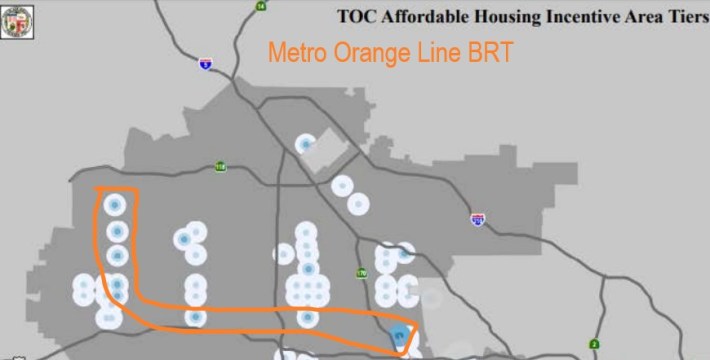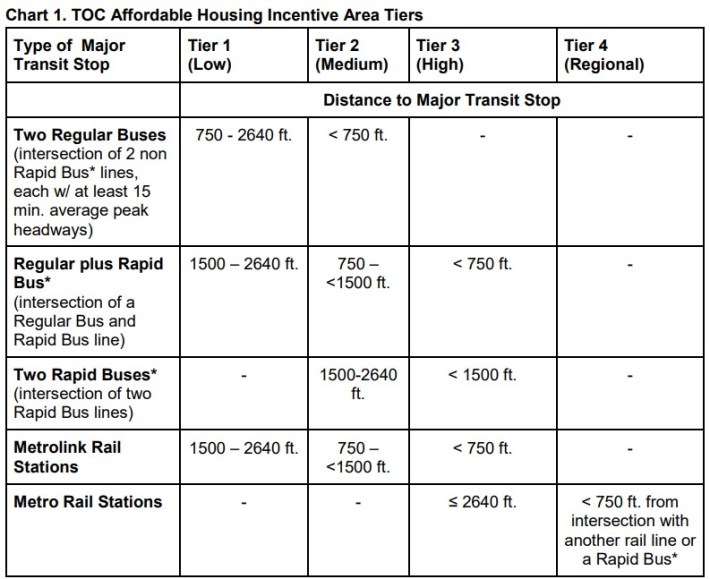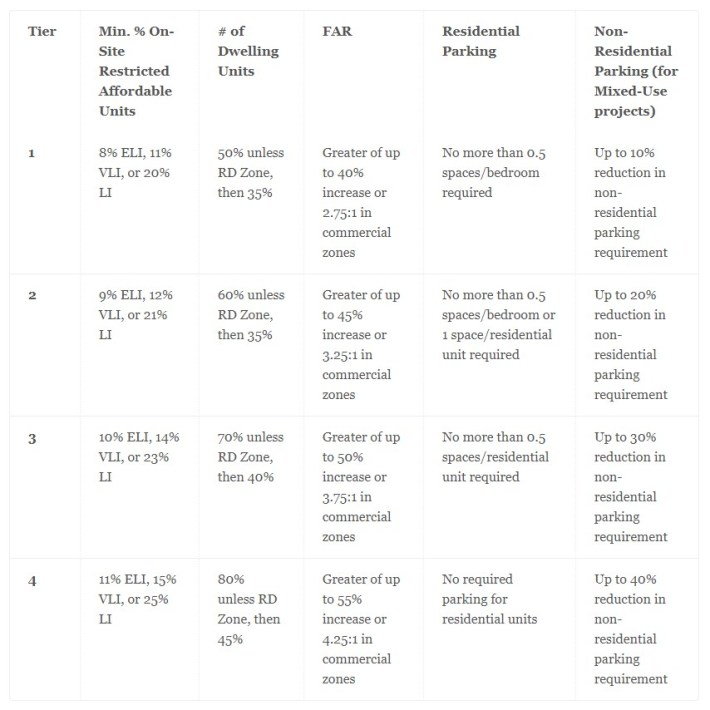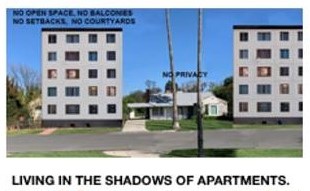If one believes the claims of Bus Rapid Transit opponents, BRT has a tremendous power to "automatically" up-zone entire corridors and bring massive new "six-story" canyons of towering development to L.A. neighborhoods. Their rhetoric is, of course, overblown. The truth is that current "automatic up-zoning" is very limited and very targeted.
The primary program under fire here is the city of Los Angeles' Transit Oriented Communities (TOC) Affordable Housing Incentive Program. (Technically, TOC incentives are discretionary bonuses - semantically not what planners would term an up-zone - but for this article SBLA will go with the vernacular and call these bonuses an up-zone.) TOC was approved by a majority of city voters in 2016. The program has been effective in greenlighting 4,000 new homes. TOC is now receiving criticism from various homeowner interests, and is the subject of a questionable Fix the City lawsuit that seeks to halt the program.
Metro is working to implement Bus Rapid Transit lines in the San Fernando Valley and connecting North Hollywood to Pasadena via the Los Angeles City neighborhood of Eagle Rock. In recent months, there have been numerous claims about how Bus Rapid Transit projects would dramatically up-zone Los Angeles communities:
- Jay Beeber claimed that "The [North San Fernando Valley] busway will trigger automatic Up-Zoning. Allowing giant apartment buildings to be built along Nordhoff [Street] towering over our single family homes."
- Keep L.A. Moving's Eagle Rock site claimed that BRT "might put the development of high-density housing up to six stories tall along Colorado Boulevard on the fast track."
- In a comment at Streetsblog, Keep L.A. Moving Chief Analytics Officer John Russo stated that "LA’s TOC up-zoning is not dependent on the intersection of two bus lines. It is applicable to a ½ mile radius around any transit station, rail, ferry terminal served by bus or rail, the intersection of two or more bus routes AND any bus route that has a service interval of 15 minutes or less. ...all sections of the proposed Chatsworth to NoHo BRT, and the portions of the NoHo to Pasadena BRT that are in Los Angeles, [are] vulnerable to up-zoning per [TOC]"
- City Councilmember John Lee, when he was running in a special election for his seat in CD12, stated (minute 1:44) "when they talk about up-zoning, this [Nordhoff BRT] definitely qualifies for all the different programs, for all the different things that Sacramento is trying to push on us." Lee's candidate website claimed, "The proposed [Nordhoff BRT] busway would almost certainly trigger automatic up-zoning along the route. This will lead to higher density projects to be built without input from the community."
- At the July 17 meeting of the Metro board Planning and Programming Committee, County Supervisor Hilda Solis stated (minute 27) "This last Saturday we had a Metro sponsored meeting in Eagle Rock... talking about BRT. The question came up from residents regarding zoning up - and the fact that there may be some potential displacement. So that is a concern that's valid."
What's the truth? Will BRT corridors really fill with six-story apartment buildings? Will BRT up-zoning cause displacement?
The Truth Is Complicated.
Briefly:
- There is no automatic up-zoning for market-rate housing.
- There is no automatic up-zoning for single-family home zones.
- Where BRT replaces existing frequent Rapid bus service, there is no automatic up-zoning.
- Where BRT adds high-quality bus service that doesn't already exist, it would trigger automatic bonuses under TOC - only at intersections where BRT meets other high-quality bus lines.
- With BRT, TOC bonuses would add at most 2 additional stories only very close to locations where multiple bus lines intersect - not entire corridors.
- Displacement would be minimized because TOC bonuses are only for affordable housing, and TOC requires minimum of one-to-one replacement of any affordable housing demolished.
Triggering "Sacramento" Programs? No
Today, there is no automatic up-zoning from Sacramento. When Councilmember Lee says this he is wrong.
The bogeyman here is Senator Scott Wiener's transit density bill S.B. 50, which died in committee in May. Note that S.B. 50 would have automatically allowed those 6-story buildings next to rail stations only. S.B. 50 would have allowed somewhat denser development at BRT stations, but would not have changed existing height limits.
The above parameters are from the most recent version of S.B. 50 which the state legislature did not approve. A future version that might ultimately pass could well be watered down, though it is not very productive to speculate what some future passable version might include. In any case, up-zoning contingent on the future passage of state legislation cannot be called "automatic."
Along the BRT Corridor? Not All Along but Intermittent
The up-zoning claims use the word "along" rather vaguely. Some residents and Keep L.A. Moving assert that up-zoning would resemble a six-story tall canyon. This is not the case.
No up-zoning would occur along an entire transit line. TOC up-zoning is very targeted. TOC would only apply very close to major bus stops - places like Reseda/Nordhoff where multiple bus lines intersect. There are no TOC bonuses more than half a mile from a major multi-bus-line intersection.

TOC up-zoning is not a continuous canyon, but an incentive for intermittent clustering of affordable homes only at bigger intersections where there are multiple transit options.
Six-Story Buildings? No
Take a look at similar transit corridors already built in Los Angeles.
- The San Fernando Valley has one of L.A.'s rare BRT lines. The Orange Line BRT opened in 2005 and development along that corridor looks much the same as it did when the BRT opened. There are a handful of six-plus-story tall buildings at North Hollywood, which is served by both BRT and the Red Line subway. There are some similarly tall buildings in Warner Center, though not quite along the Orange Line. The Valley has had more than a decade of BRT and 99+% of the line has no six-story buildings to show for it.
- The rail line closest to Northeast L.A.'s Eagle Rock is the Gold Line light rail, which opened in 2003. These neighborhoods also look largely the same as they did then. In Northeast L.A. with rail (a stronger pull for new development than BRT), in the decade-plus that the line has been in operation, there are fewer than two dozen new transit-oriented developments - in Lincoln Heights, Highland Park. The tallest ones are four stories.
For any BRT project, the biggest TOC bonus would be two bonus stories (see TOC details below). For BRT TOC to get to six stories, the site would already have to have zoning for four stories. This is not the case at stops on Metro's planned BRT corridors.
In Eagle Rock, the three proposed Colorado Boulevard stations areas (Colorado/Broadway, Colorado/Eagle Rock Blvd, and Colorado/Townsend) are zoned for only two stories. For added affordable housing, any TOC up-zoning would mean at most four-story buildings, not six.

North Valley BRT stations are similar; places like Reseda/Nordhoff have mostly one-story buildings, with occasional two- or three-story buildings. These intersections could see at most five stories under TOC. (Only one proposed BRT station site - Van Nuys/Roscoe - would get more upzoning, actually six stories. But not from BRT, but from Metro's East San Fernando Valley light rail line, expected to open in 2027.)
Displacement? TOC Up-Zoning Is Designed to Minimize This.
Gentrification and displacement are complex, multi-faceted. Displacement certainly occurs in places without good transit (for example in Echo Park) and fails to occur in places with good transit (for example along the Blue Line in South Los Angeles.)
Often gentrification is exacerbated by public investments. Improving parks, schools, transit - including rail and BRT - can improve property values, increase rents, and displace existing residents. One big way that new transit can be harmful is that it can contribute to an influx of new market-rate housing. Often a new rail station can make a lower-income community more desirable for developers to build new market-rate or luxury housing. That new housing can displace residents by tearing down existing affordable housing and by driving up rents in the area.
BRT's TOC up-zoning only applies to affordable housing. For new L.A. transit - rail, BRT, bus lines - there is no automatic up-zoning for market-rate housing.
Public Counsel's Doug Smith, who worked on Measure JJJ, stresses that TOC is designed to minimize displacement. TOC requires a minimum 1-to-1 replacement of any affordable housing demolished for new TOC development. TOC works to ensure that affordable housing increases in areas where transit investment makes development more attractive. In gentrifying areas, where there is new development, BRT TOC up-zoning would incentivize including more affordable homes.
Smith states that TOC alone is not enough to combat displacement, but that the city should also act to protect tenants and stabilize rents.
What's in Transit Oriented Communities (TOC) Incentives?
There are four tiers of TOC upzoning: tier one bonuses are minimal, tier four bonuses are relatively generous. Below is the official matrix showing the locations where tiers apply:

Note that there is no broad up-zoning along an entire corridor. All TOC up-zoning is confined within at most a half-mile of a major transit stop.
BRT automatic up-zoning occurs where adding BRT service would bump an intersection up a tier. Note that a BRT project cannot bump anything into the fourth tier, because Tier 4 is only rail.
What is in each tiers is somewhat complicated - and difficult to translate from planner-speak to everyday English.
Base TOC affordable housing incentives include: increased density, increased Floor Area Ratio (FAR), and reduced parking. UCLA environmental law professor Julia Stein relates that the TOC "base incentives alone are pretty significant... TOC incentives can mean big increases in density and FAR, especially for mixed-use projects, and are designed to reduce or eliminate what would otherwise be significant parking requirements." See Stein's excellent explainer which applies TOC to a couple of example developments showing what up upzoning results.

In addition to the base TOC incentives, developers may negotiate with the Planning Department for additional incentives in return for meeting enhanced affordability requirements. These additional incentives include reduced setbacks/yard/open space, increased lot coverage, or additional height.
The TOC guidelines specify the maximum additional height bonus for each tier:
- Tier 1 and 2 – One additional story up to 11 additional feet
- Tier 3 – Two additional stories up to 22 additional feet
- Tier 4 (rail stations only) – Three additional stories up to 33 additional feet
(Note, too that under California's density bonus program, any site can already get one extra story for including affordable housing. In effect, BRT TOC bonuses would provides, at most, one extra story from what is available with the same mixed-income project today.)
There are many more details available in the full Department of City Planning TOC Guidelines document.
Changing the Focus: Up-Zoning Adding Affordable Housing Near Transit Is Good
The fact that TOC only does very focused bonuses - not in single-family zones, only for affordable housing, only close to stations - probably won't convince anti-BRT forces to embrace BRT. Even if the threat of continuous six-story buildings is actually more like some intermittent three- and four-story affordable housing, many nimbys may still oppose even limited additional development.
TOC incentives foster additional new much-needed affordable housing.
L.A faces serious homelessness, housing affordability, displacement, and climate crises today. TOC is one important tool that helps the city take worthwhile steps toward solving all of these crises. Opposing BRT and opposing transit-oriented affordable homes will exacerbate L.A.'s inequitable status quo.







